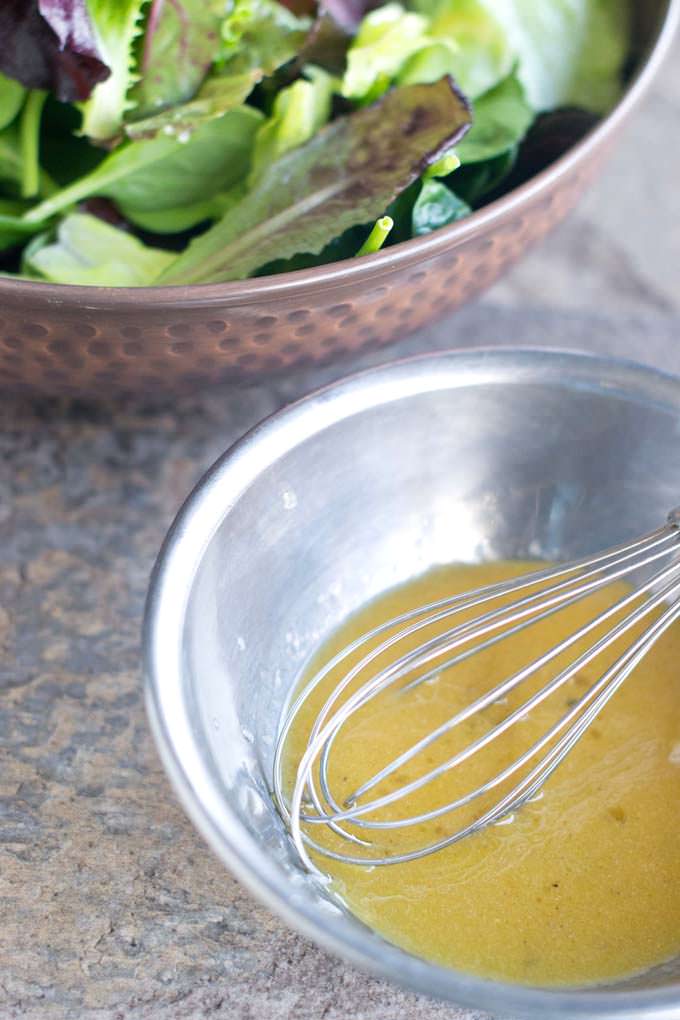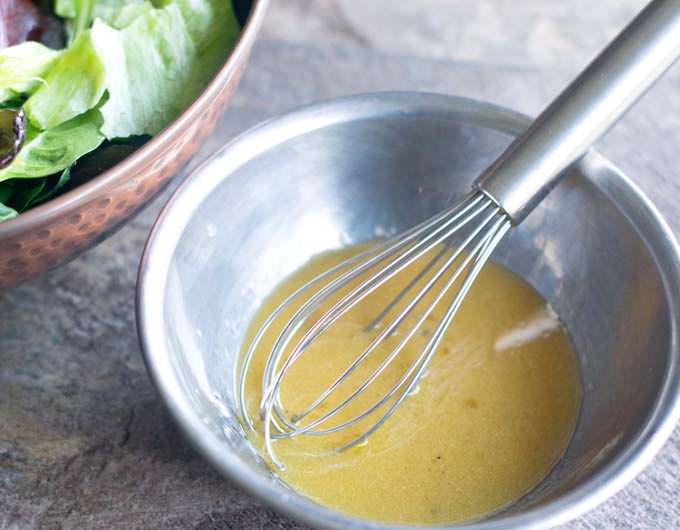Get our your greens because we’ve got the perfect classic vinaigrette over here today. With tons of tips and ideas too! Our Salad Dressing topic is brought to you by Stonyfield Organic.
Vinaigrettes are classic salad dressings that are simple and easy to make at home. Get the details below or click here to go directly to the recipe.

What Is A Vinaigrette?
A classic vinaigrette, for dressing a salad, is made of 1 part acid (vinegar or lemon juice, usually) to three parts oil. That gives you a good balanced flavor that isn’t too tart or astringent. That’s the basics, but you can play with the flavors to make it anything but boring.
Basic Vinaigrette Ratio: 1 part acid + 3 parts oil, add flavors from there.
How To Make A Vinaigrette
Step #1: Acid
First, measure your acid into a blender, bowl or jar. This can be citrus juice, like in a Lemon Vinaigrette recipe, or a type of vinegar. My recipe below uses red wine vinegar, but balsamic or sherry vinegar are often used as well.
Step #2: Flavor
Add some seasonings. Go in with salt and pepper for sure. Minced fresh garlic or garlic powder are a popular addition. You can add some fresh ginger for a more Asian flavor. Fresh or dried herbs of all kinds are great.
Basically, any seasoning or flavoring ingredient that you like. Add a little to start. You can always taste it at the end and add more.
Step #3 (Optional): Emulsifier
Next, add an emulsifier. This isn’t strictly required. You can make a good vinaigrette without one. What does the emulsifier do? It helps to keep the oil and vinegar attached to each other so that the oil isn’t just floating on top of the vinegar. You can get a salad dressing to emulsify without adding an emulsifier but it won’t stay bound together for as long. I like using Dijon mustard.
Emulsifier choices:
- Raw egg or raw egg yolk (if you’re worried about the raw aspect, you can buy pasteurized eggs)
- Mustard (Dijon or a whole grain mustard are best)
- Honey
- Maple syrup
- Mayonnaise
- Yogurt
Step #4: Oil
Finally, add in your oil. This can be an oil with flavor, like an infused oil or walnut or olive oil. Or it can be a basic flavorless oil like grape seed or vegetable oil.
If you’re using a blender, start it running and slowly drizzle in the oil. This method tends to stay emulsified and stable for the longest.
If you’re using a bowl, get out your whisk. Put the bowl on a kitchen hand towel so that it’s less likely to move around. Start whisking the vinegar and then very slowly drizzle in the oil.
If you’re using a jar, pour the oil into the jar and put the lid on. Shake it lots.
Step #5: Taste Test
It’s time to taste your vinaigrette. But don’t dip a spoon in there to taste it. It’s going to taste way too strong and awful. Get yourself a salad leaf and dip it. Add more seasonings if needed. If it’s just not quite right for you, try the solutions below.
Vinaigrette Not Quite Right?
If it’s too tart, add some honey or a pinch of sugar. For a dressing that is too sweet, add a bit more vinegar (you’ll need to whisk, shake, and blend again).
If it feels like it’s just missing something, there are a couple things you can do. If your main acid was a vinegar, adding a tiny squeeze of lemon or lime juice can really brighten it all up. Another ingredient that quickly transforms salad dressing is fish sauce. Just a tiny tiny drip. The dressing won’t taste Asian at all. The fish sauce just adds a meatiness. Anchovy paste, just a dab, will also add some savory umami. Soy sauce works less well but is a good option, as is tomato paste.
There you have it. A perfect classic vinaigrette. We’ve given you some basic amounts below, but experiment and play around. We know you’re going to create some amazing things!
Print
Classic Vinaigrette Recipe
Get our your greens because we’ve got the perfect classic vinaigrette over here today.
- Prep Time: 5 minutes
- Cook Time: 0 min
- Total Time: 5 minutes
- Yield: 1 cup 1x
- Category: Sauce
- Method: No-Cook
- Cuisine: American
Ingredients
- 1/4 cup red wine vinegar
- 2 tsp Dijon mustard
- 1/2 tsp salt
- 1/4 tsp pepper
- 3/4 cup olive oil
Instructions
- Measure the vinegar, mustard, salt, and pepper into a blender, medium bowl, or a jar.
- If you’re using a blender, start it running and slowly drizzle in the oil (this method tends to stay emulsified and stable for the longest).
If you’re using a bowl, get out your whisk. Put the bowl on a kitchen hand towel so that it’s less likely to move around. Start whisking the vinegar and then very slowly drizzle in the oil.
If you’re using a jar, pour the oil into the jar and put the lid on. Shake it lots.
Love this recipe? I’d appreciate it if you could scroll down and add a *5 star rating* to help others know they’ll love it as well!
This post originally appeared in March 2016 and was revised and republished in January 2023.